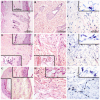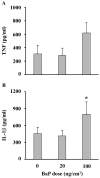Impact of Skin Exposure to Benzo[a]pyrene in Rat Model: Insights into Epidermal Cell Function and Draining Lymph Node Cell Response
- PMID: 39201318
- PMCID: PMC11354278
- DOI: 10.3390/ijms25168631
Impact of Skin Exposure to Benzo[a]pyrene in Rat Model: Insights into Epidermal Cell Function and Draining Lymph Node Cell Response
Abstract
The skin is a direct target of the air pollutant benzo[a]pyrene (BaP). While its carcinogenic qualities are well-studied, the immunotoxicity of BaP after dermal exposure is less understood. This study examines the immunomodulatory effects of a 10-day epicutaneous BaP application, in environmentally/occupationally relevant doses, by analyzing ex vivo skin immune response (skin explant, epidermal cells and draining lymph node/DLN cell activity), alongside the skin's reaction to sensitization with experimental hapten dinitrochlorobenzene (DNCB). The results show that BaP application disrupts the structure of the epidermal layer and promotes immune cell infiltration in the dermis. BaP exposure led to oxidative stress in epidermal cells, characterized by decreased reduced glutathione and increased AHR and Cyp1A1 expression. Production and gene expression of proinflammatory cytokines (TNF, IL-1β) by epidermal cells decreased, while IL-10 response increased. Decreased spontaneous production of IFN-γ and IL-17, along with unchanged IL-10, was observed in DLC cells, whereas ConA-stimulated production of these cytokines was elevated. Local immunosuppression caused by BaP application seems to reduce the skin's response to an additional stimulus, evidenced by decreased effector activity of DLN cells three days after sensitization with DNCB. These findings provide new insight into the immunomodulatory effects and health risks associated with skin exposure to BaP.
Keywords: draining lymph nodes cell activity; epicutaenous benzo[a]pyrene application; epidermal cell activity; rats; skin explants.
Conflict of interest statement
The authors declare no conflicts of interest.
Figures





Similar articles
-
Impact of the magnitude of sensitization dose on the incidence and intensity of CHS to dinitrochlorobenzene (DNCB): insight from ear swelling and challenged-skin draining lymph node response in rats.J Immunotoxicol. 2013 Oct-Dec;10(4):355-60. doi: 10.3109/1547691X.2012.753960. Epub 2013 Apr 24. J Immunotoxicol. 2013. PMID: 23614785
-
Comparison of benzo[a]pyrene-DNA adduct levels in mouse and rat epidermis and dermis.Cancer Lett. 1986 Jan;30(1):35-9. doi: 10.1016/0304-3835(86)90129-1. Cancer Lett. 1986. PMID: 3943078
-
Profiles of cytokine mRNAs in the skin and lymph nodes of SENCAR mice treated epicutaneously with dibenzo[a,l]pyrene or dimethylbenz[a]anthracene reveal a direct correlation between carcinogen-induced contact hypersensitivity and epidermal hyperplasia.Mol Carcinog. 2000 Feb;27(2):125-40. doi: 10.1002/(sici)1098-2744(200002)27:2<125::aid-mc8>3.0.co;2-0. Mol Carcinog. 2000. PMID: 10657905
-
Epidermal cytokinetics, DNA adducts, and dermal inflammation in the mouse skin in response to repeated benzo[a]pyrene exposures.Toxicol Appl Pharmacol. 1996 Jan;136(1):67-74. doi: 10.1006/taap.1996.0007. Toxicol Appl Pharmacol. 1996. PMID: 8560481
-
Exposure of human skin to benzo[a]pyrene: role of CYP1A1 and aryl hydrocarbon receptor in oxidative stress generation.Toxicology. 2010 May 27;271(3):83-6. doi: 10.1016/j.tox.2010.02.014. Epub 2010 Mar 20. Toxicology. 2010. PMID: 20307623
Cited by
-
Glutaminolysis impairment and immunometabolic dysregulation in U937 cells: Key mechanisms in occupational and environmental skin exposure to UV and benzo[a]pyrene.Arch Toxicol. 2025 Aug 25. doi: 10.1007/s00204-025-04155-4. Online ahead of print. Arch Toxicol. 2025. PMID: 40855183
References
-
- Luo K., Stepanov I., Hecht S.S. Chemical biomarkers of exposure and early damage from potentially carcinogenic airborne pollutants. Ann. Cancer Epidemiol. 2019;3:5. doi: 10.21037/ace.2019.08.01. - DOI
-
- Bourgart E., Persoons R., Marques M., Rivier A., Balducci F., von Koschembahr A., Beal D., Leccia M.-T., Douki T., Maitre A. Influence of exposure dose, complex mixture, and ultraviolet radiation on skin absorption and bioactivation of polycyclic aromatic hydrocarbons ex vivo. Arch. Toxicol. 2019;93:2165–2184. doi: 10.1007/s00204-019-02504-8. - DOI - PubMed
-
- Finardi S., Radice P., Cecinato A., Gariazzo C., Gherardi M., Romagnoli P. Seasonal variation of PAHs concentration and source attribution through diagnostic ratios analysis. Urban Clim. 2017;22:19–34. doi: 10.1016/j.uclim.2015.12.001. - DOI
MeSH terms
Substances
Grants and funding
LinkOut - more resources
Full Text Sources

